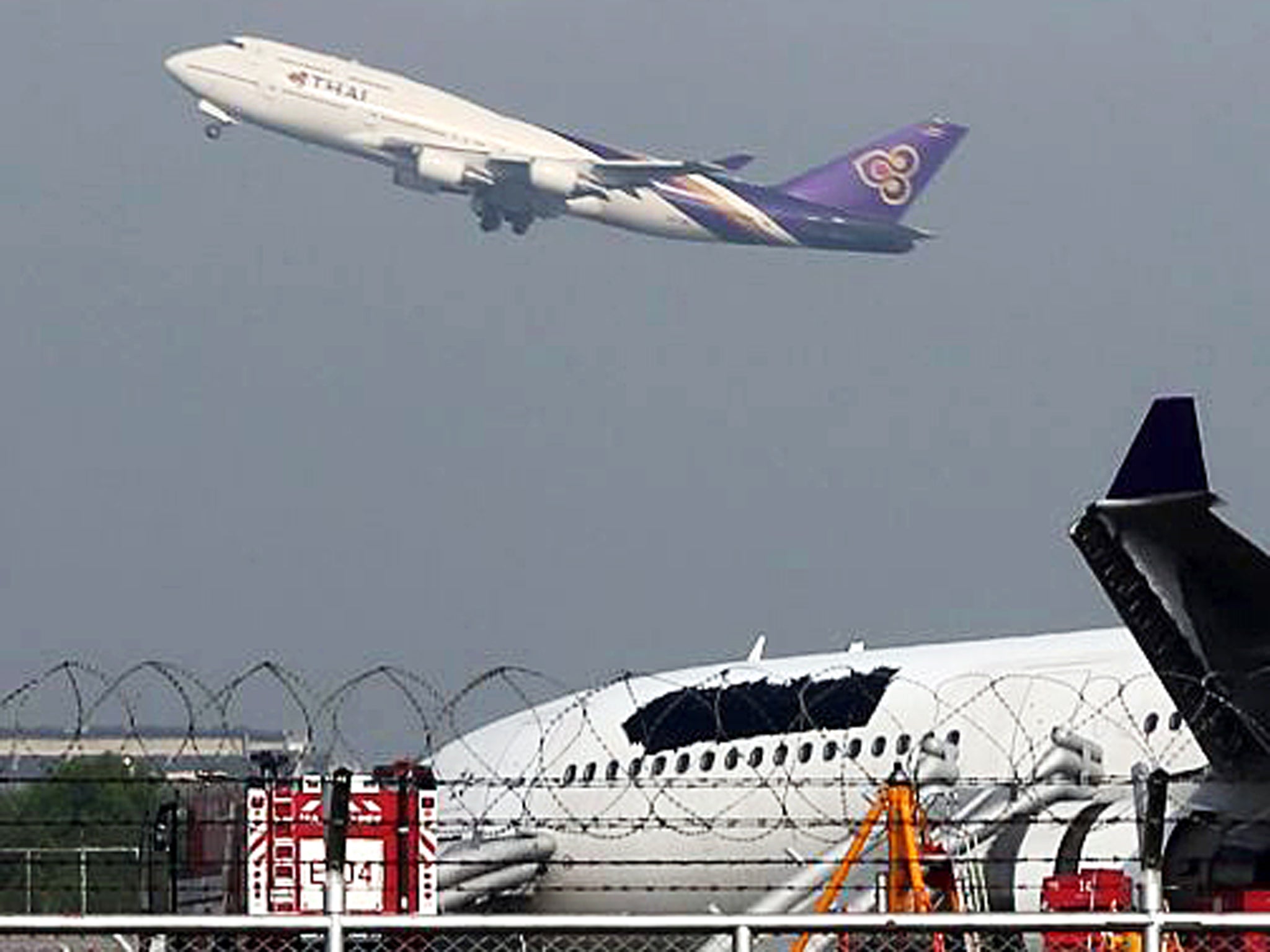Simon Calder: How a minor prang became a major case of 'de-identification'
The man who pays his way

Thai Airways flight 679 from Guangzhou did not arrive at Bangkok in the conventional manner. The Airbus A330 ran off the runway onto the grass. No one was harmed during this alarming experience, but in the subsequent evacuation 13 people were hurt. And shortly afterwards, Thai's reputation suffered a self-inflicted mauling.
The picture above shows what happened next. You might imagine Thailand's national carrier would devote all its efforts to caring for passengers and managing the considerable disruption after one runway was closed. In fact, some of its resources were spent on a botched attempt to conceal its involvement in what, in air-safety terms, was an insignificant prang.
The kindergarten-grade emergency paint job to black out the word "Thai" from the fuselage and tail hardly chimes with the airline's slogan, "Smooth as silk". You might presume it was a rogue decision – perhaps a panicking manager asking a couple of hapless employees to obliterate the name, forgetting the airline has spent a marketing fortune on the purple, pink and gold that make its identity so recognisable.
Yet the decision was taken at a higher level. Initially, a Thai Airways spokesperson told me it is the policy of Star Alliance, the grouping to which the airline belongs: "The blurring of the logo is a practice Star Alliance members are recommended to do known as the 'crisis communication rule'. It is meant to protect both the image of the airline and other members of Star Alliance."
This staggering assertion suggested that, in the event of an incident involving a Star Alliance member, the first thought of carriers such as Lufthansa and Singapore Airlines is to minimise the risk of contamination by disassociating themselves from the event.
Shortly afterwards, the spokesperson issued a "slight change of communication", saying: "It is not a Star Alliance policy or procedure to de-identify aircraft." They confirmed, though, that "Thai generally practises the de-identifying of an aircraft after an incident (or accident)."
Deploying people (and presumably some Thai dye) to "de-identify" a stricken plane in a vain bid to pretend the airline wasn't involved seems to me a peculiar priority on the part of the airline. Nothing to see here, people, move along now.
BA shows the way
Perhaps Thai's bosses had in mind Pan Am 103 – the jumbo jet blown out of the skies 25 years ago en route from Heathrow to New York. Fragments of the 747 in a field near the town of Lockerbie, showing the aircraft name, Clipper Maid of the Seas, became the image of this tragedy. Some old aviation hands say that the familiar blue-and-white livery hastened the demise of Pan Am, which failed three years later.
The travelling public is smarter than that. If an airline responds to an incident professionally and respectfully, its reputation may actually be enhanced.
On 22 August 1985, British Airtours flight 28M caught fire on the ground at Manchester airport. Many survived the ordeal, but 53 passengers and two crew died. British Airtours was the holiday charter subsidiary of British Airways.
The parent company, to its enduring credit, made no attempt to distance itself from the offshoot. Instead, BA took full responsibility. The airline threw all its efforts and expertise into helping the families of the victims, assisting survivors and working with accident investigators to understand the chain of events that led to the tragedy. Many lessons were learned from the disaster about such survivable accidents, such as the need for emergency floor lighting to guide passengers to the nearest exit.
Since the Manchester tragedy, BA has earned a formidable reputation as one of the safest airlines in the world. In contrast, the botched attempt by Thai Airways to disguise its involvement in an incident heaps nothing but ignominy upon an otherwise excellent airline.
Given Thai Airways' apparent desperation to disassociate itself from the Bangkok incident, I wondered what the airline had to hide. It turns out that, since 1980, Thai has suffered five fatal crashes. I would not have found that out, and you would not have read it, were it not for this ludicrous late-night paint job at Bangkok. As in so many areas of life, the cover-up has proved much more damaging than the original issue.
Out of Africa
BA has had its own communication breakdown this week. Last week it announced the short-notice cancellation of the route to the Zambian capital Lusaka. Flights end next month.
When a UK airline axes a route, it is obliged to offer booked passengers a choice of a full refund or alternative flights. In the case of Lusaka, that should mean BA paying for connecting flights to and from an airport that the airline still serves, such as Nairobi. But that's not what the carrier initially told disappointed passengers.
Emma Coupe and her fiance, Giles, are flying to Lusaka for their honeymoon. Inconveniently, BA axes the route while they are away. Emma told me: "We have been offered replacement flights home from Entebbe, Nairobi or Johannesburg. But we have to pay to get ourselves to any of these locations. Is this right?"
No. BA says call-centre staff were mistaken; the airline will pay for a connection to Nairobi.
Subscribe to Independent Premium to bookmark this article
Want to bookmark your favourite articles and stories to read or reference later? Start your Independent Premium subscription today.

Join our commenting forum
Join thought-provoking conversations, follow other Independent readers and see their replies